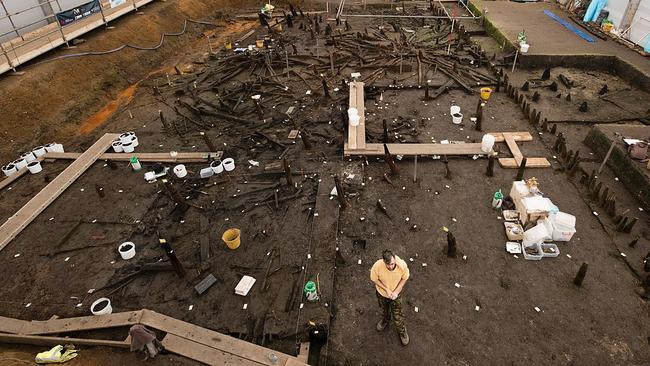Gut instincts about a Bronze Age dinner
Bronze Age inhabitants of ‘Britain’s Pompeii’ were plagued by giant intestinal worms.

Ancient excrement has provided a window into how the Bronze Age inhabitants of a settlement known as “Britain’s Pompeii” were plagued by giant intestinal worms after feasting on raw fish and frogs.
In about 1000BC, Must Farm, located in the Fens near what is now Peterborough, comprised several timber-framed roundhouses, built on stilts above a shallow river and connected by wooden causeways. Dugout log canoes were used for transport. The village was burnt down in a suspected act of arson and an extraordinary array of artefacts was preserved in waterlogged mud, including stacked crockery, bronze tools and linen textiles with a thread count higher than our own summer clothing.
The site has been called the Pompeii of the Fens for the insight it has given into everyday Bronze Age life.
Also preserved in the mud were waterlogged “coprolites” — pieces of human and animal faeces that have now been collected and analysed by archaeologists at the University of Cambridge. The researchers were able to recover 15 coprolites; four were identified as human and seven as canine.
Microscopic analysis detected ancient parasite eggs. The dog droppings contained the same parasite eggs, suggesting that the humans of Must Farm shared their food with them.
“We have found the earliest evidence for fish tapeworm, Echinostoma worm, and giant kidney worm in Britain,” said Piers Mitchell, co-author of a study published yesterday in the journal Parasitology.
“These parasites are spread by eating raw aquatic animals such as fish, amphibians and molluscs. Living over slow-moving water may have protected the inhabitants from some parasites, but put them at risk of others if they ate fish or frogs.”
Fish tapeworms can reach 10m in length. They live coiled up in the intestines and a heavy infection can lead to anaemia. Infections have increased in recent years, due to the popularity of sushi, smoked salmon and ceviche.
Giant kidney worms can reach up to a metre in length.
The kidney worms gradually destroy the organ as they become larger, leading to renal failure. Echinostoma worms are much smaller, up to 1cm in length, and can cause inflammation of the intestinal lining.
“As writing was only introduced to Britain centuries later with the Romans, these people were unable to record what happened to them during their lives. This research enables us for the first time to clearly understand the infectious diseases experienced by prehistoric people living in the Fens,” said Marissa Ledger, a colleague of Dr Mitchell at Cambridge’s Department of Archaeology.
The Times



To join the conversation, please log in. Don't have an account? Register
Join the conversation, you are commenting as Logout